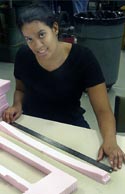 |
||
|
|
||
|
|
 INTERVIEW See how Courtney built the Felsenau Model. Choose your connection speed: 56K 300K PHOTO ALBUM See how Courtney built the Felsenau Bridges Model. |
THE
STRUCTURES LAB Courtney and Joe Vocaturo designed and fabricated models
of Christian Menn’s Felsenau and Sunniberg Bridges. First, she
created three-dimensional computer models of the structures using the
program Pro/Engineer. With the help of Glenn Northey from the Department
of Mechanical and Aerospace Engineering, she then programmed the CNC
machine to use codes generated by Pro/Engineer to mill the individual
bridge pieces. For the Felsenau Bridge, she made prototypes of the components
in foam, and then the final pieces were cut from plastic. Unfortunately,
the plastic pieces warped a bit in the process, but Courtney was able
to solve the problem by heating them in an oven and reshaping them.
The model was assembled and mounted on an aluminum honeycomb base, which
was covered by a landscape of fiberglass-covered foam with plywood sides.
The basic construction for the Sunniberg model is similar to the Felsenau.
She used Pro/Engineer and the CNC machine to make the towers; however,
the material used was aluminum not plastic. The deck is made of Plexiglas®,
cut on the laser cutter with cables of nylon to attach the deck to the
towers.
GLOSSARY
I ACKNOWLEDGMENTS
I RELATED
LINKS |
|
